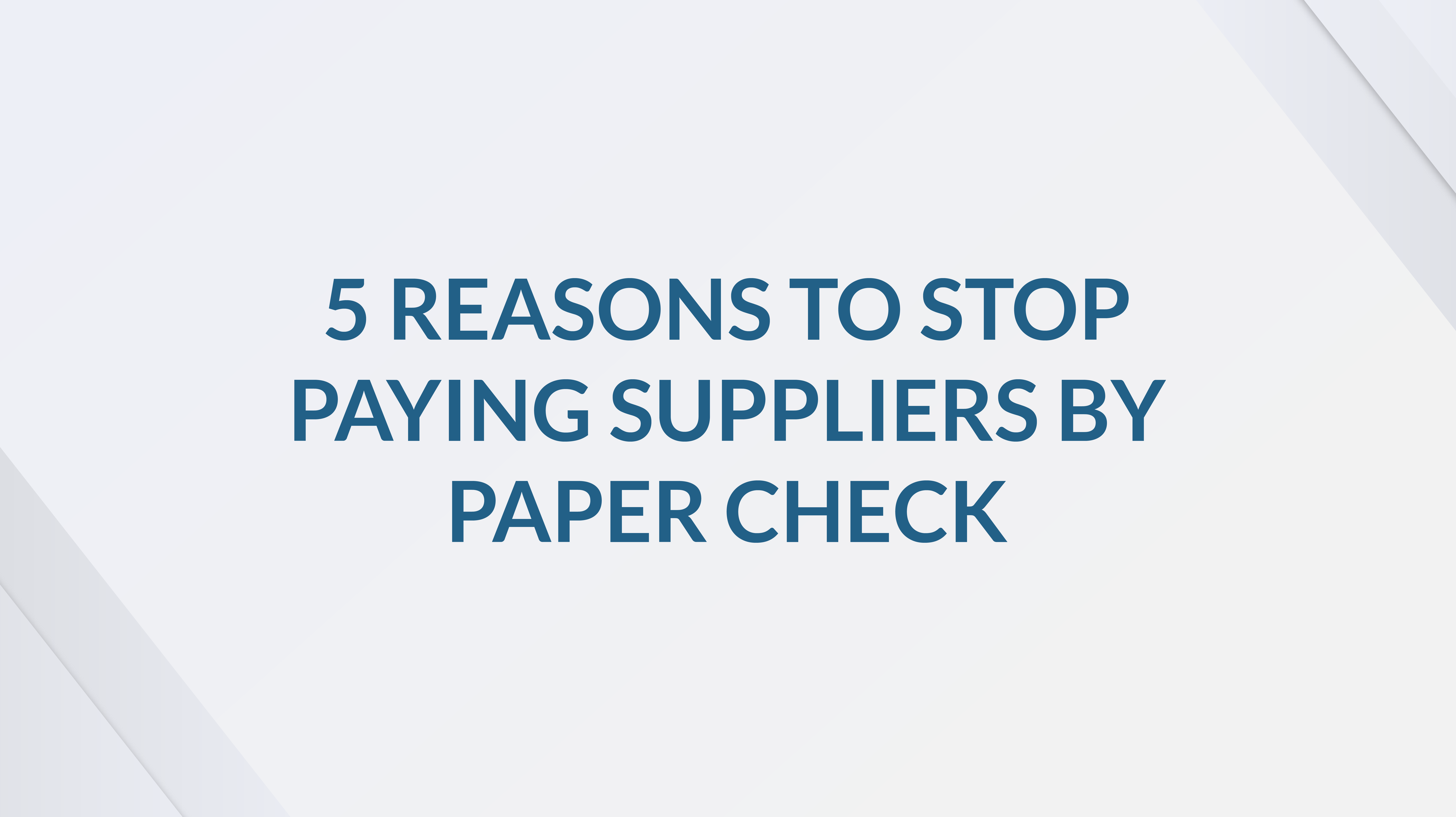Automated Accounts Receivable Programs: Cutting DSO by 30% in Six Months
In today’s economy, speed to cash is as important as speed to market. Companies that let receivables linger for 60, 75, or even 90 days are putting...

Eliminating B2B paper checks not only streamlines your AP processes, but it also reduces costly errors, prevents fraud, and speeds up digital transformation of your business.
In the old days of B2B payments processing, digital payments were something unaffordable for most small businesses due high technology costs and the lack of IT infrastructure.
Fast forward to the world today and it’s clear that technological advancements have transformed the way we communicate, make purchases, and receive goods and services—both in our professional and in our personal lives. Subsequently, small businesses have ample opportunities to stop paying suppliers via paper checks and instead pay them with virtual cards and other forms of digital payments.
Why, then, areover 30% of businesses still paying suppliers by paper checks?
Answers vary, but here are some commonly stated reasons:
“It’s the way we’ve always done it.”
“We don’t want to deal with processing fees.”
“Our suppliers don’t accept virtual payments.”
“We don’t have the technology to run digital payments.”
While these reasons certainly hold validity, they’ve also been challenged since the COVID-19 outbreaks in 2020 when many businesses shifted to remote work and had to rethink their payment processing as a result. It was this transition away from paper documents that business managers and stakeholders began to understand why making digital payments to suppliers can be superior to making paper check payments.
All things considered, here are five key reasons your business should start transitioning away from paper checks:
Check fraud is a crime no business wants to deal with; not only does it cause unnecessary monetary loss, but it can result in identity theft, credit damage, and troubled relationships with suppliers.
To put this into perspective, research by industry analysts has revealed that business check fraud is the number one form of payment fraud and affects approximately 74% of organizations. Across 2022, in fact, the Financial Crimes Enforcement Network (FinCEN) reported 680,000 incidents of possible check fraud in the United States—a increase of nearly 52% from 2021.
While all check types are prime targets for theft, business checks are generally the most lucrative because the amount of money involved generally totals much more than consumer checks and it often takes longer periods of time for a business to realize a crime has occurred.
As far as how checks get stolen, statistics show that they are commonly intercepted right from recipients’ mailboxes, altered, and presented to financial institutions for payment. But these crimes don’t just originate from rogue criminals and crime networks; some businesses have seen checks altered by suppliers and even their own employees. Other businesses have discovered that their own employees have accessed check stock, created fake invoices to alleged suppliers, printed fraudulent checks, and subsequently cashed them.
If your business has experienced check fraud or attempts at check fraud, it’s time to re-evaluate your policies and focus on how you can provide better financial oversight through innovation and technology. Byautomating your entire AP process and switching to electronic payments such as ACHs and virtual cards, it’s possible to reduce or even eliminate check fraud entirely.
How many checks does your business send to suppliers each month?
And how much time does your staff spend preparing and mailing those checks?
Bank of America estimated almost a decade ago thatit was costing between $4 and $20 for a business to process a single check. With inflation persisting, that number is likely much higher today.
Altogether, if you add up the true cost of processing paper checks, you may be surprised to learn how much your business actually spends on this task. Besides making payment approvals, signing checks, printing paper checks, and posting to the ledger, there’s also managing the postage fees, bank fees, and other costs associated with manual check processing.
But processing costs aren’t the only thing you should be considering. There’s also an opportunity cost because your employees are spending time doing tasks that could easily be automated instead of spending time on high-value tasks. Ask yourself this: What would your employees be doing with their time if they weren’t processing paper checks? What could they do to improve other operations within your business?
If you’re still paying suppliers by paper check, it would be beneficial to research your estimated costs and find out how AP automation can reduce your business’s overall invoice and payment processing time. Some businesses using APSmart by CloudX have reported they’ve been able to digitize up to 100% of all invoices and automatically approve and post up to 70% of all invoices.
Good financial oversight is key to growing a profitable and sustainable business. Unfortunately, many businesses still issuing paper checks have limited visibility of processes across their AP workflows. This can lead to payment errors, limited knowledge of payments statuses, and higher overhead costs from having to manually search for information. Beyond these problems, paper checks make it more difficult to record financial transactions, analyze payment data, perform month-end closes, and conduct audits.
Another aspect of limited spend visibility involves vendor relationships. Processing errors, slow mail delivery times, and lost checks have been known to negatively affect relationships and even result in loss of business with suppliers. This can force a business to seek out alternative suppliers who may not offer the best prices or payment terms.
Do you have visibility of your business’s spend? If not, it’s more likely you will go over budget, make duplicate or erroneous purchases, and overpay or underpay suppliers.
By automating your business’s AP processes and moving away from paper checks, you will have easier access to payment information and reports so you are able to make better business decisions—whether you’re running your month-end closing, performing an audit, or preparing for tax season. Overall, theincreased visibility offered through AP automation can help you determine exactly how your funds are being allocated and what they’re being spent on.
Good cash flow is essential to your business’s success and assures you can pay suppliers, invest in new ventures, and become more profitable. But did you know that cash flow problems are responsible for82% of business failures in the United States? The reality is, cash flow is much more than just money in, money out. It’s also about making decisions to help maximize your available cash, avoid financial difficulties, and increase your profitability.
When you use paper checks to pay suppliers, cash flow management can be difficult. Due to check float, you never know when money will leave your bank account or when you may need to contact suppliers for follow up. In the long run, you’re less able to perform accurate cash flow forecasting and it’s tougher to use cash as working capital.
Switching to digital payments presents the opportunity to pay suppliers by virtual card, which gives your AP department much more control over when cash leaves your accounts. If you’re unfamiliar with virtual cards, they are simply digitized credit cards that allow you to pay your suppliers quickly and securely. With them, you can also set customized spending limits, see payments processing in real time, extend your Days Payable Outstanding (DPO), and maintain more capital float.
When it comes to payment processing, checks are the least-secure method for moving money and completing business transactions. One of the top concerns with checks is that information like routing and account numbers, bank information, names, addresses, and phone numbers are readily available. This information can give an opportunistic criminal all they need to forge or duplicate a check.
Switching to digital payments eliminates the ability for unauthorized individuals to access information typically found on checks and also prevents payments from physically getting lost en route to suppliers. Additionally, by making payments through an automated accounting platform, efficiency and accuracy of transactions tend to improve and account reconciliation becomes much easier.
Here are the most common digital payments used today, and why they’re more secure than checks:
ACH: According to data from NACHA, the organization that oversees the ACH network, fewer than 0.03% of all ACH transactions are returned unauthorized. ACH transactions are a highly secure form of payment overall, especially when a vendor’s payment and routing information is set up through a secure online portal with encrypted file transfer and storage capabilities.
Credit Cards: Corporate credit cards are a way that businesses can fast track their vendor payments securely and efficiently. Besides being quicker than check and ACH payments, credit cards give businesses the ability to track payments, use available cash as working capital, and visualize all expenditures.
Virtual Cards: A virtual card is similar to a credit card but is 100% digital. Each time a virtual card is used to pay a supplier, a unique 16-digit number is generated. This number sequence can never be used again, making virtual cards one of the most secure payment methods available today. Besides gaining enhanced security, businesses can gather valuable cash rebates on their spend, which can generate thousands of dollars in additional revenue each year.
Even if your business isn’t ready to move away from paper checks, adoptingan end-to-end AP automation solution is an excellent way to add transparency and security to your payment processes. With it, you’ll be able to organize payments into one centralized payment flow and make payments visible to team members according to your business’s unique specifications.
Now that you know why it’s so important to move away from paper check payments, it’s time to make AP automation a part of your new payment processing strategy. Please contact CloudX today for a complimentary demo of their APSmart and PAYSmart software automation solutions.

In today’s economy, speed to cash is as important as speed to market. Companies that let receivables linger for 60, 75, or even 90 days are putting...

Managing operational costs today often means balancing operational costs against tight margins, making it essential to join a group purchasing...